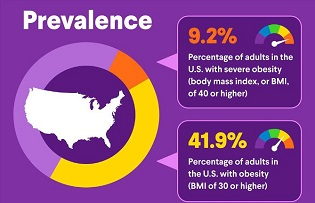Treatment and Goals
Planning and Treatment, Stage 1

Planning and Treatment, Stage 1
Stage 1 obesity means you have no known weight-related complications and can move around with relative ease. Meanwhile, any psychological conditions or internalized weight bias you may have do not have a major impact on your quality of life.
Keep in mind that having stage 1 obesity still raises your risk of developing obesity-related complications including many types of cancer.
Treatment plans for stage 1 obesity focus on making lifestyle changes to lose weight or prevent additional weight gain. Here's why: While you have no weight-related complications now, you could develop them down the line. Shedding excess weight — or staying at your current weight — can reduce your risk of future complications and weight-related cancers.
Please note: Obesity is a chronic disease, not a lifestyle choice. However, making lifestyle changes is a critical step in treating obesity and avoiding weight-related health problems.
Stage 1 obesity treatment typically includes taking steps to reduce chronic disease risk and changing your behavior habits. Key treatment strategies are:
Learn more about each treatment strategy below.
Setting Realistic Weight Management Goals
At the beginning of your obesity journey, try setting a modest goal — say, loss of 5%-10% of your body weight over the course of six months. This amount of weight loss has been shown to provide benefits in many obesity-related complications, including diabetes, high blood pressure, and non-alcoholic fatty liver disease. Once you meet that goal, you and your health care professional can set a new one.
Losing a lot of weight may require setting new goals multiple times. By working with your health care professional, you can establish realistic goals that will produce results and motivate you to succeed.
Healthy Eating
Eating a healthy diet that includes nutrient-rich foods in right-size portions is one of the best changes you can make for your weight and health.
Keep the following tips in mind as you think about healthy eating — and be sure to ask your health care professional for whatever guidance and support you need.
- What to eat: A healthy diet includes a wide range of nutritious foods, including fruits, vegetables, whole grains, lean meats, poultry, eggs, seafood, low-fat dairy, nuts, seeds, legumes, and healthy fats.
- What to avoid: A healthy diet limits highly processed foods; sugar-sweetened beverages; alcohol; and foods with added sugar, saturated fats, trans fats, or sodium.
- Portion control: No matter how healthy your diet is, you'll lose weight only if you eat the correct number of right-size portions. A good source of information about portion control is the U.S. Department of Agriculture's MyPlate Plan.
- Calorie control: For slow, steady weight loss, many health care professionals recommend reducing daily calorie intake by 500-750 calories. You and your health care professional can decide together how many calories you need each day. In a typical healthy eating plan, total daily calorie goals that include a reduction in calories for weight loss range from 1,200-1,600 for women and 1,500-1,800 for men. However, this varies for each person.
If you're currently following a calorie goal but not achieving any weight loss, you're taking in too many calories to lose weight. Your health care professional may recommend cutting your daily calories by an additional 100-200 calories. Your height, starting weight, and activity level all help determine what your daily calorie intake should be.
Meal plans to follow: Let your health care professional know if you'd like to follow a specific meal plan. Good options include the Mediterranean diet, the Dietary Approaches to Stop Hypertension (DASH) eating plan, and the MyPlate Plan.
Your health care professional may also recommend other types of eating plans, such as a low-carbohydrate or low-fat food plan, a low-calorie/high-volume food plan, a high-protein food plan, vegetarian eating, intermittent fasting, or a plan that substitutes some of your meals with meal-replacement drinks. Each of these plans has different pros and cons. Your health care professional can recommend the plan that's best for you.
A very-low-calorie diet is an option for some individuals, but it requires medical supervision and should be followed only if your health care professional recommends it.
Need extra support? Ask your health care professional to refer you to a registered dietitian or health educator.
Physical Activity
Increasing your physical activity burns calories and speeds up weight loss. It provides many other benefits, too, such as lower blood pressure, improved cholesterol levels, better heart health, stronger bones and muscles, better sleep, and improved mood. By getting moving, you help yourself in multiple ways.
Your health care professional will give you guidance on how much exercise you can do, what types of activities are best for you, and what types of exercise to avoid because of physical limitations or other factors.
Keep the following tips in mind as you think about physical activity — and be sure to ask your health care professional for whatever guidance and support you need.
- How much exercise to do: Any amount of exercise can benefit your health. But the general recommendation for physical activity is:
- 150 minutes per week of moderate-intensity physical activity (e.g., walking, swimming, biking, or playing tennis).
- Two days per week of muscle-strengthening activity that works all major muscle groups (i.e., legs, hips, back, abdomen, chest, shoulders, and arms). Strength training builds muscle mass, which contributes the most to metabolic rate. It's also very important for bone health.
- How to get started: It's fine to start with short bouts of activity and to increase duration over time. Start with something simple, such as walking a few minutes a day. As you become fitter, you'll be able to increase your walking distance and intensity. About 30 minutes a day, five days a week, is recommended. Alternatively, you could exercise for a longer duration on fewer days. Keep in mind that you can break up your activity into several shorter sessions throughout the day.
- Pick something you enjoy: You're more likely to stick with activities that you enjoy. No interest in jogging? No problem. Walk, hike, dance, play pickleball, or take a Zumba class instead.
- Work activity into your everyday life: Spending time with a friend? Go for a walk instead of a meal. Watching TV? Lift some weights while you watch. And your dog will love it if you start taking them out for extra walks.
- Track your progress: Using a step counter or other tracking tool may help you stay committed to exercise. The standard recommendation is 10,000 steps a day, but don't feel you have to start with that many steps. Begin with what feels doable, and gradually increase your daily step count goals over time.
- Join a gym — or not: Lots of people enjoy exercising at a gym, working out with a trainer, or participating in group exercise classes. But that doesn't mean you have to invest in a gym membership if you're not a fan of gyms. All you need to get started is a comfortable pair of shoes and a place to walk. You could also check out the many free exercise classes available online.
- Reduce sedentary behavior: Have a job that requires long hours of sitting? Try to schedule frequent breaks throughout the day to stretch or walk around, even if just for a couple of minutes.
Need extra support? Ask your health care professional to refer you to a physical therapist or medical exercise program.
Shared Decision-Making
You and your health care professional will work together to create a personalized treatment plan that's right for you and helps you manage your weight in a healthy way. Along the way, your health care professional will continuously assess your goals and the success of your treatment plan. If you're not meeting your weight management goals despite good effort with lifestyle changes, your health care professional may talk with you about weight-management medication.
Note: Obesity pharmacotherapy, metabolic and bariatric surgeries, and metabolic endoscopic procedures may be considered at any stage of obesity, including stage 1. Treatment decisions should be made through a shared decision-making process between you and your health care professional. These interventions can be appropriate at any stage to support your lifestyle goals and improve your overall health.





 DOWNLOAD
DOWNLOAD





